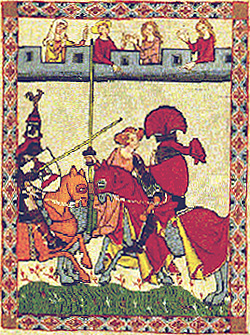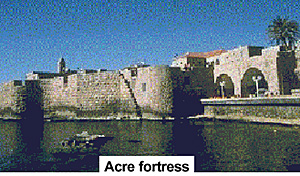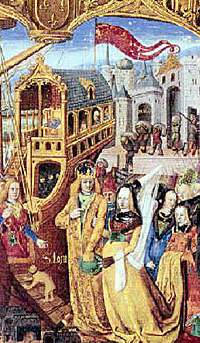 We generally think of the Crusades as being a time when the men would go off and fight the infidel, and the
women -- their wives, daughters, sisters, and mothers -- waiting patiently for them at home. One of the most touching
portrayals of the "Crusader widow" is the twelfth century memorial to Count Hugh de Vaudémont and his wife, Anne
of Lorraine. Hugh was imprisoned in the Holy Land for sixteen years; when his death was reported, Anne was
frequently urged to remarry, but she always firmly refused. The sculpture, at the priory of Belval, in Lorraine, in
Nancy, preserves for all time that moment when Count Hugh returned to his Anne.
We generally think of the Crusades as being a time when the men would go off and fight the infidel, and the
women -- their wives, daughters, sisters, and mothers -- waiting patiently for them at home. One of the most touching
portrayals of the "Crusader widow" is the twelfth century memorial to Count Hugh de Vaudémont and his wife, Anne
of Lorraine. Hugh was imprisoned in the Holy Land for sixteen years; when his death was reported, Anne was
frequently urged to remarry, but she always firmly refused. The sculpture, at the priory of Belval, in Lorraine, in
Nancy, preserves for all time that moment when Count Hugh returned to his Anne.
We must remember, however, that the story of Anne and Hugh is one of the very few such tales that ends so happily. Even during those times when the crown was entrusted with the protection of Crusaders' property, the experiences of those women left behind to look after home and family could be downright horrifying. William Trussel's wife, for example, was murdered just six weeks after her husband left on crusade in 1190, her body thrown into a pit.
Ballads
The ballads of the day were infused with the bittersweet tales of parted lovers, as in Ahi! Amours, written by Conon de Béthune about a year before the siege of Acre began:
- Oh, Love! How hard it will be for me to have to leave
the best woman who was ever loved or served!
May God, in His kindness, lead me back to her as surely I leave her in sorrow.
Alas! What have I said? I am not really leaving her at all!
If my body is going off to serve Our Lord, my heart remains entirely within her sway.
Ahi! Amours is but a small sample of the vast amounts of songs contemporary to the siege of Acre which were written along these lines -- whether from the point of view of the lord on crusade or the lady he left behind (the chansons de femme) -- a fascinating form of propaganda which bears examining. The Crusades had, to some extent, revived the whole notion of courtly love. The departure for the Holy Land separates the poet from his lady, bringing him great anguish and misery; and yet, in his heart, he knows that she will only despise him if he remains at home, which will mean that he will lose her.
This, of course, is a departure from the songs of the First and Second Crusades, which mostly reiterated the points of Pope Urban II's sermon at the Council of Clermont; this was an era when it would seem that terrestrial love, and not love of God, inspired men to take up the cross. Routledge, however, proposes a different derivation for the spate of love-ballads that sprung up in the early years of the Third Crusade:
The features which characterize the expression of the fin'amor in the songs of the troubadours, trouvères and Minnesänger are longing, tension which is unresolved, and praise of the beloved. These features can be developed in a number of ways. For example, if the tension is unresolved, we may be told the reason why: the lady is of such supreme character and status, so "distant" from the lover that he despairs of ever attaining the lofty heights where she dwells. There may be other obstacles and dangers: actual distance, rivals, gossipmongers (known as losengiers), or the lover's timidity.
It is not difficult to see how such elements of the love-song may be transferred to the idea of crusading. The unresolved longing may express the intention, as yet unfulfilled, to go on the crusade, or it may be used to suggest the idea of the journey which seems so long and to which no end can clearly be seen.
In reality, however, there were quite a number of women who went to the Crusades -- despite the fact that the papal bull that launched the Third Crusade forbade women to participate. Even Pope Urban II, in his sermon/call to arms at the Council of Clermont in 1095 which incited the Crusades, advised women against taking crusade vows, as well as the elderly, the infirm, clerics, and monks. However, the promise of eternal reward in the hereafter would certainly seem to outweigh Urban’s attempt at dissuasion.
 In the same sermon, Urban often underscored the fact that "if anyone who sets out should lose his life
either on the way, by land or by sea, or in battle against the infidels, his sins shall be pardoned from that moment."
As an example, let us focus on the arrival of King Richard at the siege of Acre on June 8, 1191. Richard brought
with him twenty-five galleys full of reinforcements, but it is worth discussing two other passengers as well. Richard
had only days before married Berengaria of Navarre, and crowned her Queen of England. Richard's mother, Eleanor of
Aquitaine, who had held a pivotal role in the Second Crusade, and who had selected Richard's bride, was sent home
to assist her son John rule England in Richard's absence after the wedding. Berengaria's chaperone was Richard's
sister, Joanna (who had until a short while before been the Dowager Queen of Sicily).
In the same sermon, Urban often underscored the fact that "if anyone who sets out should lose his life
either on the way, by land or by sea, or in battle against the infidels, his sins shall be pardoned from that moment."
As an example, let us focus on the arrival of King Richard at the siege of Acre on June 8, 1191. Richard brought
with him twenty-five galleys full of reinforcements, but it is worth discussing two other passengers as well. Richard
had only days before married Berengaria of Navarre, and crowned her Queen of England. Richard's mother, Eleanor of
Aquitaine, who had held a pivotal role in the Second Crusade, and who had selected Richard's bride, was sent home
to assist her son John rule England in Richard's absence after the wedding. Berengaria's chaperone was Richard's
sister, Joanna (who had until a short while before been the Dowager Queen of Sicily).
Berengaria and Joanna had traveled together all the way from Europe; it was said that they became very good friends, "like two doves in a cage." Isaac Ducas Comnenus, the deposed Emperor of Sicily, was a captive in the charge of Guy of Lusignan, King of Jerusalem; Isaac's young daughter was attached to the court of Queens Joanna and Berengaria, to learn the Western way of life.
Queens
Other noblewomen were undoubtedly in attendance at the siege of Acre as well. The wives of noblemen could play an important role in the Holy Land -- according to feudal custom, a wife could succeed her husband and could theoretically find herself at the head of a fief, perhaps even the Kingdom of Jerusalem. Salic law was simply not invoked in that era.
 We know that Queen Berengaria and Queen Joanna were at the siege at its close, when Richard entered the city
and claimed the palace within as his prize, sending his bride and sister and their retinue to dwell therein. We know that they and
their courts did not leave for England until quite a few months later. But what were they doing at the siege of Acre? One author
romantically imagines the queens happy in each other's company, embroidering in a fortress within the camp in the care of two
guardian knights. Perhaps so; but there is simply no evidence indicating what Berengaria and Joanna spent their days doing, only that they were together, and present during what
remained of the siege.
We know that Queen Berengaria and Queen Joanna were at the siege at its close, when Richard entered the city
and claimed the palace within as his prize, sending his bride and sister and their retinue to dwell therein. We know that they and
their courts did not leave for England until quite a few months later. But what were they doing at the siege of Acre? One author
romantically imagines the queens happy in each other's company, embroidering in a fortress within the camp in the care of two
guardian knights. Perhaps so; but there is simply no evidence indicating what Berengaria and Joanna spent their days doing, only that they were together, and present during what
remained of the siege.
McLennan more realistically suggests that "the new Queen would not have found her groom physically attractive during an illness that deprived him of his hair, and in which his skin peeled off in strips. Indeed, perhaps she too suffered the same illness, and was confined to her own sickbed."
Following the siege of Acre, Eastern and Western accounts both speak of a proposal regarding Queen Joanna; Beha al-Din, Saladin’s biographer, attributes the proposal to Richard himself, but some Western accounts, including Ambroise's, consider Saladin to have originated the proposal.
The proposal went like this: Queen Joanna would marry Saladin’s brother al-`Adil; the couple would live in Jerusalem, where they would rule jointly; all prisoners taken at the siege of Acre would be released; and the fragment of the True Cross which Saladin kept in his possession would be entrusted to Joanna and al-`Adil jointly. But the proposal fell through, and here again, the accounts differ as to the reasons.
Beha al-Din blames Richard, the "accursed Englishman," who had said that "his sister had returned home in a terrible rage when she was told about his proposal: she had sworn that she would never give herself to a Muslim!" In any case, the proposal fell through; Saladin kept his piece of the True Cross, the Crusaders slaughtered their prisoners, and Saladin's troops killed or enslaved their own prisoners. The Third Crusade would continue.
 Crusading Women
Crusading Women
There were women who fought at siege of Acre. `Imad al-Din wrote of one Western noblewoman who was a queen in her own land, and arrived accompanied by five hundred knights with their horses and money, pages and valets, she paying all their expenses and treating them generously out of her wealth. They rode out when she rode out, charged when she charged, flung themselves into the fray at her side, their ranks unwavering as long as she stood firm.
The story of the noblewoman Crusader is not new to the Third Crusade; about ninety years before the siege of Acre, during the Second Crusade, Ida of Austria fought in the company of Duke Welf of Bavaria, and disappeared during the battle of Heraclea, when the Western forces were annihilated.
While `Imad al-Din seems to speak admiringly of the unnamed queen, both he and Ibn al-Athir are somewhat disparaging of many of the other women who were among the Western fighting forces. Among the Franks there were indeed women who rode into battle with cuirasses and helmets, dressed in men's clothes; who rode out into the thick of the fray and acted like brave men although they were but tender women, maintaining that all this was an act of piety, thinking to gain heavenly rewards by it, and making it their way of life. Praise be to him who led them into such error and out of the paths of wisdom! On the day of battle more than one woman rode out with them like a knight and showed (masculine) endurance in spite of the weakness (of her sex); clothed only in a coat of mail they were not recognized as women until they had been stripped of their arms. Some of them were discovered and sold as slaves.
Gabrielli notes, however, that a passage in the chronicles of Usama ibn Munqidh, the Emir of Shaizar, demonstrates that Eastern women were equally willing to take up arms when necessary.
Women also helped by bringing water to the thirsty, or with the effort to carry stones to fill in the moat that surrounded the walls of Acre. Ambroise, thought to have been a soldier among the Western troops who had arrived at the siege at about the same time as King Richard, writes of a woman who is shot by a Saracen archer; her dying wish is that her corpse be used to fill the moat.
`Imad al-Din also complains that: “Everywhere was full of old women. These were sometimes a support and sometimes a source of weakness. They exhorted and incited men to summon their pride, saying that the Cross imposed on them the obligation to resist to the bitter end, and that the combatants would win eternal life only by sacrificing their lives, and that their God's sepulchre was in enemy hands. Observe how men and women led them into error; the latter in their religious zeal tired of feminine delicacy, and to save themselves from the terror of dismay (on the day of Judgement) became the close companions of perplexity, and having succumbed to the lust for vengeance, became hardened, and stupid and foolish because of the harm they had suffered.” These women could very well have been nuns. Noblewomen often included a few nuns in their court or among their traveling companions. Several of the military orders, including the Hospitallers of St. John, Santiago, and Calatrava, included convents of sisters, generally more devoted to a contemplative life than to the care of the sick.
As there was no concept of a nun in the Islamic religious structure, it seems likely that such nuns would fit `Imad al-Din's description. It is equally likely that he speaks of female pilgrims -- for there may have been men and women at the siege of Acre who had traveled as pilgrims to the Holy Land, only to be caught in the the battle. Much of their role, if they too were not actively volunteering as water-bearers or stone-bearers or such, might well have been as such cheerleaders, exhorting the fighters on to triumph.
Oldest Profession
And lastly, we come to those women who came to the siege to be employed in the world's oldest profession. In a long and colorful passage from his account of the siege of Acre, `Imad ad-Din writes that
"There arrived by ship three hundred lovely Frankish women, full of youth and beauty, assembled from beyond the sea and offering themselves for sin. They were expatriates come to help expatriates, ready to cheer the fallen and sustained in turn to give support and assistance, and they glowed with ardor for carnal intercourse. They were all licentious harlots."
While `Imad ad-Din implies that there were no prostitutes in his own camps, he does admit that "a few foolish Mamluks and ignorant wretches slipped away, under the fierce goad of lust, and followed the people of error." Indeed, the siege of Acre was marked by a greater extent of debauchery, quarrelling, famines, and sicknesses, than perhaps any other single military action of the Crusades -- not surprising for a gathering of thousands of men from all over Europe, forced to stay entrenched in a seemingly endless siege initially without a center of direction.
Women served in a variety of capacities among the army of the Crusaders, from simple pilgrim, to"bearing the cross" as a combatant.
Back to Cry Havoc! # 46 Table of Contents
Back to Cry Havoc! List of Issues
Back to MagWeb Master Magazine List
© Copyright 2004 by David W. Tschanz.
This article appears in MagWeb.com (Magazine Web) on the Internet World Wide Web. Other articles from military history and related magazines are available at http://www.magweb.com